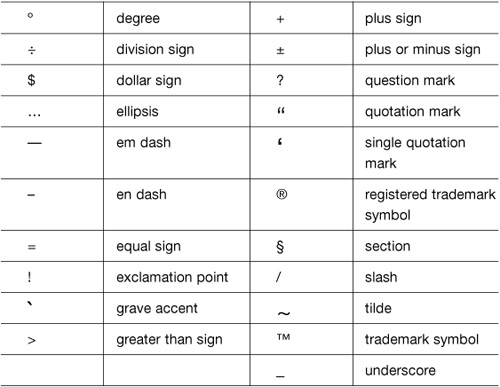S
SAME
Don’t use same to refer to the subject of a sentence.
Incorrect: Your letter arrived and I acknowledge the same with thanks.
Correct: Your letter arrived and I acknowledge it with thanks.
SARCASM
Sarcasm is a figure of speech that describes a passage where the author means the opposite of what is actually said. Sarcasm is a form of irony. Sarcastic remarks are often rude or humorous.
Example: Maybe you should talk on the phone a little louder. I don’t think everyone in the office could hear your conversation.
SATIRE
Satire is a literary technique where an author makes fun of someone or something in order to create a negative opinion. Satire often uses humor to ridicule the subject.
An author often uses satire to express a strong opinion about someone or something in order to damage or ruin the subject of the satire.
SCREEN
SCREEN TERMINOLOGY
The screen captures in Figures 2.5 to 2.9 illustrate various features of Microsoft Windows–based software for the purpose of identifying elements that may appear in software-related procedures and manuals.
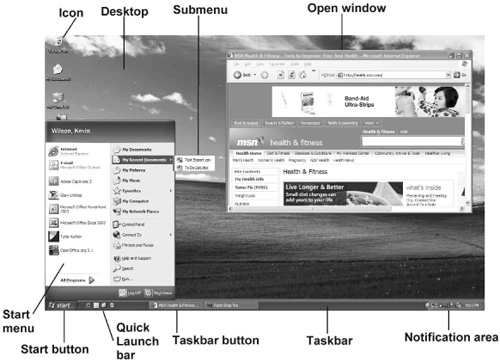

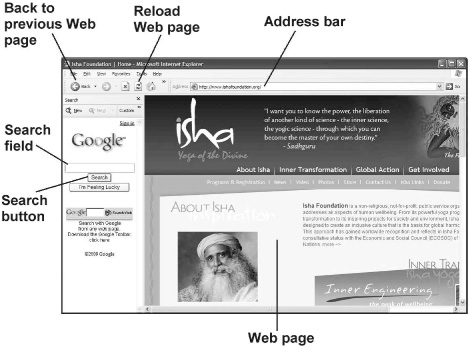
Figure 2.9 Program Window

SECOND CONDITIONAL
The second conditional is used to express future actions that depend on the result of another future action. Usually, there is only a small chance both conditions will be satisfied.
The second conditional is formed with if + past simple tense + would + base form.
Example: If I found a buried treasure, I would buy my own island.
SELECT
See Press, Type, Click, Strike, Hit, Select.
SEMICOLON
A semicolon is used when the conjunction is omitted between parts of a compound sentence.
Example: I went with them; I should have stayed at home.
A semicolon precedes words such as however, moreover, or otherwise when they introduce the second of two connected full sentences.
Example: She is arriving at noon; however, she will not stay long.
If parts of a series contain inner punctuation such as a comma, the parts are separated by a semicolon.
Example: He came to see his mother, who was ill; his sister, who lived in the next town; and his old schoolmate.
SEMIWEEKLY, SEMIMONTHLY
See Biweekly, Bimonthly, Semiweekly, Semimonthly
SENSOR, CENSOR
See Censor, Censure, Sensor, Censer.
SENTENCE
A sentence has a subject and a verb (predicate) that can stand alone.
A sentence starts with a capital letter and ends with a period, question mark, or exclamation mark.
SENTENCE FRAGMENTS
A sentence fragment fails to be a sentence because it cannot stand by itself. It does not contain at least one independent clause.
A group of words may appear to be a sentence but turn out to be a sentence fragment instead for several reasons:
![]() The sentence fragment may contain a series of prepositional phrases without a proper subject-verb relationship.
The sentence fragment may contain a series of prepositional phrases without a proper subject-verb relationship.
Example: in Texas, sometime in early April, just before the bluebonnets appear.
![]() The sentence fragment may be a verbal phrase intended to modify something that is missing.
The sentence fragment may be a verbal phrase intended to modify something that is missing.
Example: working deep into the night in an effort to get his taxes complete
![]() The sentence fragment may have a subject-verb relationship, but it has been subordinated to another idea or word so that it cannot stand by itself.
The sentence fragment may have a subject-verb relationship, but it has been subordinated to another idea or word so that it cannot stand by itself.
Example: although he was taller than his older brother.
SENTENCE SUBJECT
The subject of a sentence is the person, place, or thing that is the main agent in the sentence.
To find the subject of a sentence, first locate the verb. Then answer the question, what or who is being “verbed”?
Example: The monkeys in the treetops must be observed.
[verb; So, what must be observed? The answer is the monkeys.]
A simple subject is a subject without any modifiers.
Example: The upcoming event [simple subject], stripped of all the hype, is nothing but a fund-raiser.
Sometimes a simple subject can be more than one word or even an entire clause.
Example: What he had forgotten about the law was amazing considering how many years he spent in law school.
Usually, when the subject of a sentence is you and the sentence is a suggestion, order, or command, the you is left out.
Example: Get out of the way! [You is understood to be the subject.]
For sentence analysis, the person who initiates an action in a sentence is called the agent. When the active voice is used, the subject is the agent.
Example: The class [subject/agent] failed the test.
When the passive voice is used, the agent is not the subject. Some passive sentences don’t contain an agent.
Example: The test was failed by the class [object of the preposition “by”].
SENTENCE TYPES
The types of sentence structures are:
![]() Simple—one independent clause
Simple—one independent clause
Example: He went to the store.
![]() Compound—more than one independent clause
Compound—more than one independent clause
Example: He went to the store, and he bought groceries.
![]() Complex—one independent clause and at least one dependent clause
Complex—one independent clause and at least one dependent clause
Example: He went to the store, where he bought groceries.
![]() Compound complex—more than one independent clause and at least one dependent clause
Compound complex—more than one independent clause and at least one dependent clause
Example: He went to the library, and then he went to the store, where he bought groceries.
![]() Periodic—beginning with modifying phrases and clauses and ending with an independent clause
Periodic—beginning with modifying phrases and clauses and ending with an independent clause
Example: Having gone to the store, he bought groceries.
![]() Cumulative—beginning with an independent clause and ending with a series of modifying constructions
Cumulative—beginning with an independent clause and ending with a series of modifying constructions
Example: He ran his morning errands, buying groceries, dropping off his prescription, and getting cash from the ATM.
SENTENCE VARIETY
A sentence is a group of words containing a subject and a predicate.
How you use the many types of sentences in your writing, the order in which you use them, and how you combine and punctuate them determine your writing style.
It is relatively easy to write short sentences. However, if you use only short sentences, your writing will appear to be a primer style and give your reader a poor impression of your level of professionalism. To write more complicated sentences, you have to create constructions of clauses and phrases. Consider these tips:
![]() Long sentences and run-on sentences are not the same thing.
Long sentences and run-on sentences are not the same thing.
![]() Combining too long a series of clauses may confuse the reader.
Combining too long a series of clauses may confuse the reader.
![]() Many writers are afraid they’ll create run-on sentences and tend to lean toward the shorter variety.
Many writers are afraid they’ll create run-on sentences and tend to lean toward the shorter variety.
By coordinating clauses and punctuation, you can allow the complexity of a sentence to develop after the verb, not before it. The key is to make the subject-verb connection and then allow the sentence to paint the picture surrounding that subject and verb.
One issue that is difficult for many business writers is the need to repeat key terms in long sentences. The repetition feels awkward. When properly handled, though, repeated phrases can create a rhythm that helps to emphasize the meaning of the sentence.
Another way to enhance sentence variety and complexity is to avoid clumsy “which clauses” and replace them with dependent clauses.
Example: Atlanta continues to grow in every direction, which means that homes are rapidly replacing the fields and forests in outlying areas.
Better: Atlanta continues to grow in every direction, as homes rapidly replace the fields and forests in outlying areas.
When used sparingly, you can create an interesting twist to a sentence by ending it with a set of prepositional phrases, each beginning with a present or past participle.
Example: You’ll find working with Videologies to be an excellent experience, one that will develop into a lasting relationship, into a partnership, winning future business for us all.
Remember to throw an occasional question, exclamation, or command into your writing.
![]() Questions can be useful at the beginning of a paragraph to summarize the content that follows.
Questions can be useful at the beginning of a paragraph to summarize the content that follows.
![]() Exclamations can be used to express strong feelings.
Exclamations can be used to express strong feelings.
![]() Commands provide direction and energy by telling your readers what to do.
Commands provide direction and energy by telling your readers what to do.
Occasionally, try to begin sentences with something other than the normal subject-verb combo. Consider these tips:
![]() Start with a modifying clause or participial phrase.
Start with a modifying clause or participial phrase.
![]() Begin with a coordinating conjunction (and, but, nor, for, yet, or so).
Begin with a coordinating conjunction (and, but, nor, for, yet, or so).
![]() Many people think that they should never begin a sentence with but and that it should be linked to the previous sentence to make a compound structure. But a sentence like this calls attention to itself and can be a useful device.
Many people think that they should never begin a sentence with but and that it should be linked to the previous sentence to make a compound structure. But a sentence like this calls attention to itself and can be a useful device.
SETUP, SET UP
Setup is written as one word when acting as a noun or adjective.
Example: To install the software, run Setup [noun].
Example: The setup [adjective] process should take you approximately ten minutes.
Set up is written as two words when acting as a verb.
Example: Have you unpacked and set up your office?
SEXIST LANGUAGE
SHALL, WILL
Use shall to express a simple expected action by the first person.
Use will with second and third persons.
To express determination or command, reverse the order; use will for the first person and shall for the second and third.
Example: We shall go tomorrow.
Example: He will go, too.
Example: You will be at the conference by the time we arrive.
Example: I will go tomorrow.
Example: He shall go with me even if I must force him.
Example: You shall never do that again.
SHAPE
Don’t use shape to refer to the status of something.
Incorrect: The transaction was completed in good shape.
Correct: The transaction was completed to everyone’s satisfaction.
SHOULD, MUST
Should is used when an action is recommended but optional.
Example: I should clean the kitchen.
Must is used when an action is required.
Example: Mom said we must clean the kitchen.
SHOULD OF
See Might of, Should of, Would of, Could of.
SHOULD, WOULD
Use should with the first person and would with the second and third persons to express expected action.
Example: I should run diagnostics again to look for errors.
Example: They would expect to have dinner with us after the play.
Using should and would instead of shall and will implies a doubt that the action will take place.
Should and would may also be used with all persons, but in these cases the meaning of the verbs is different. Should may be used with all persons to show obligation. Would may be used with all persons to show intent or determination.
Correct: A child should love his parents.
Correct: If I had enough money, I would buy a car.
SHUT DOWN, SHUTDOWN
Shut down is two words when used as a verb.
Example: You should shut down your computer during thunderstorms.
Shutdown is one word when used as a noun or adjective.
Example: To turn off your computer, click Start and then Shutdown.
Sic
Sic is a Latin word that means “in such a manner.” When quoting a passage that has misspelled words or poor grammar, include [sic], italicized and within brackets, to show that the mistakes are an accurate part of the quote.
Example: Sprayed on the side of the wall was the slogan, “Eat moore chiken [sic].”.
SIGN IN, SIGN OUT, SIGN ON, SIGN UP
Sign in is used when entering a user ID and password to access a secure Web site. When you exit a secure Web site, you sign out.
Sign on is used as a noun to describe security software.
Example: The Web site features a secure single sign on.
Sign up is when you register to access a secure Web site.
SIMILE
A simile is a figure of speech that is used to describe something by comparing it to something else using words such as like or as.
Example: He was as nutty as a fruitcake.
Example: She laughs like a hyena.
SINCE, BECAUSE
SINGULAR
Singular is a grammatical term for a noun, pronoun, or verb that is used to describe something when there is only one item.
Example: an office, a car, a laptop, a telephone.
Plural is the grammatical term used when there is more than one item.
SIT, SET
Sit is an intransitive verb.
Correct: She sits near her husband at every meeting.
Correct: He sets the plates on the table in an orderly manner.
SITE, SIGHT, CITE
SLANG
Slang is informal, sometimes grammatically incorrect language that is used by groups to bind the group together.
Usage of slang often spreads outside the group and becomes mainstream informal language.
Example: That’s a cool hat you’re wearing.
Example: He definitely has his game face on.
SLASH
The slash is often used as shorthand or when the choice between alternatives is nebulous.
Because the slash is often ambiguous, use it with caution. The slash is used:
![]() With and/or combinations.
With and/or combinations.
![]() To indicate other relationships between words.
To indicate other relationships between words.
And/Or Combinations
The slash can be used to indicate:
![]() Options that are available.
Options that are available.
Example: The ingredients of the drink are ice, rum, lime/lemon, and cola.
![]() That something has more than one function.
That something has more than one function.
Example: The potter worked alone in the cold garage/studio.
Indicating Other Relationships
The slash can be used to:
![]() Separate elements that are being compared.
Separate elements that are being compared.
Example: The Redskins/Cowboys rivalry has a long history.
![]() Separate origins and destinations.
Separate origins and destinations.
Example: The Dallas/Atlanta flight was canceled.
![]() Separate the numerals in a date.
Separate the numerals in a date.
Example: 12/31/201.
![]() Indicate a period that spans two or more calendar years.
Indicate a period that spans two or more calendar years.
Example: For the 2011/12 school year, the eighth graders will be taking technology education for the first time.
![]() Mean “per.”
Mean “per.”
Example: 1000 km/hou.
![]() Write fractions.
Write fractions.
Example: 1/4 + 1/4 = 1/.
SMALL CAPS
Small caps are uppercase letters that are the same height as the surrounding lowercase letters. Small caps are often used for acronyms and abbreviations.
Example: THESE ARE SMALL CAPS.
SO
Avoid overuse of this adverbial conjunction. Consequently, therefore, and inasmuch as are good substitutes when you want to vary the style.
Avoid: It had snowed over a foot that day; so we drove the jeep into town.
Better: It had snowed over a foot that day; consequently we drove the jeep into town.
SOFTWARE MENUS AND COMMANDS
Figure 2.10 shows an example of software menu elements.
Figure 2.10 Software Menu Terminology

SOLIDUS
Solidus is another name for Slash.
SOME, ANY
SOMETIME, SOME TIME
Sometime means occasional or at some point.
Some time means an amount of time.
Correct: I will go sometime this morning.
Correct: If I have some time this morning, I shall do the job for you.
SORT OF, KIND OF
SPACES AFTER PERIODS
Only one space is needed at the end of a sentence after the period before starting another sentence. When people used typewriters, it was common to add two spaces after a period.
SPLIT INFINITIVE
One of the most common writing mistakes is the split infinitive. An infinitive is said to be split when a word (usually an adverb) is placed between the to of the infinitive and the root verb.
Example: to boldly go where no man has gone before.
The argument against split infinitives is based on the idea that an infinitive is a single unit and should not be divided. Because it is so easy to spot, many writers try to avoid a split. However, many style guides now say the rule against splitting infinitives can be ignored. To avoid the criticism, it is a good rule to avoid split infinitives in business writing.
SR., JR.
STATIVE ADJECTIVE
A stative adjective describes a condition or state that is not easily changed.
Example: large, blue, little.
STATIVE VERB
SUBHEADINGS
SUBJECT
A noun, pronoun, or noun phrase that comes before the main verb in a sentence is called the subject.
Example: She [subject] went to the warehouse.
To find the subject in a sentence, ask the question, who or what did the action expressed by the verb?
SUBJECT COMPLEMENT
SUBJECTIVE CASE
The subjective case, also called subjective pronouns, consists of personal pronouns that can act as subjects in a sentence.
Example: I, you, he, she, it, we, the.
The objective case consists of pronouns that act as objects in a sentence.
Example: me, you, him, her, it, us, you, the.
SUBJECTIVE PRONOUNS
SUBJECT-VERB AGREEMENT
The basic rule of subject-verb agreement is that a singular subject needs a singular verb and that plural subjects require plural verbs.
Example: My brother is [singular subject and verb] a psychologist.
Example: My brothers are [plural subject and verb] psychologists.
Indefinite pronouns like anyone, everyone, someone, no one, and nobody are singular subjects and thus require singular verbs.
Example: Everyone is studying hard.
Some indefinite pronouns, such as all and some, can be singular or plural depending on whether what they are referring to is countable or not.
Example: Some of the candy is missing.
Example: Some of the dogs are barking.
One indefinite pronoun, none, can be either singular or plural, and it doesn’t matter whether you use a singular or plural verb—that is, unless something in the sentence specifies its number.
Example: None of you write poetry.
Example: None of the cars are speeding.
Some indefinite pronouns like everyone and everybody sound as though they are talking about more than one person; however, they are both singular.
Example: Everyone is coming to the meeting.
The pronoun each is often followed by a prepositional phrase ending in a plural word.
Example: each of the monkey.
Each, however, is singular.
Example: Each of the monkeys is eating a banana.
Don’t confuse the word and with the phrases together with, as well as, and along with. They do not mean the same and do not create compound subjects as and does.
Example: The boy, as well as his brother, is going to school.
Example: The boy and his brother are going to school.
The pronouns neither and either are singular even though they appear to be referring to two things.
Example: Neither of the two computers is obsolete.
Example: Either is a good choice for a student.
Sometimes neither and either take a plural verb when they are followed by a prepositional phrase that begins with of.
Example: Have either of you two kids seen my dog?
Example: Are either of you listening to me.
When the conjunctions or and nor are used, the subject closest to the verb determines whether the verb is singular or plural.
Example: Neither the bear nor the monkeys were outside when we visited the zoo.
It’s also a good idea to put the plural subject closest to the verb because the sentence would be incorrect.
Example: Neither the monkeys nor the bear were outside when we visited the zoo.
The words there and here can never be subjects in a sentence. These words are used in what are called expletive constructions where the subject follows the verb and determines whether the verb is singular or plural.
Example: Here are my two books [subject].
Example: There better be a good reason [subject] you have them.
Verbs for third-person, singular subjects like he, she, and it have s endings.
Example: He loves to eat.
Sometimes modifiers slip between a subject and a verb, but they do not change the subject-verb agreement.
Example: The workers [subject], who always seem to be standing around taking a break, gathered in a circle like a football huddle, are [verb] being fired.
Sometimes nouns take peculiar forms that make it confusing to tell whether they are singular or plural. Words such as glasses, gloves, pliers, and scissors are thought of as plural unless they’re preceded by the phrase pair of, in which case pair becomes the subject.
Example: My glasses are on the desk.
Example: The pair of glasses is on the desk.
Some words that end in s seem to be plural but are really singular and thus require singular verbs.
Example: The evening news is full of disasters.
Other words that end in s refer to a single thing but are actually plural and require a plural verb.
Example: His assets were totally wiped out by the bankruptcy.
Fractional expressions, such as half of and a percentage of, can be either singular or plural. The same is true when words like some, all, and any serve as subjects.
Example: One-half of the population is over sixty-five.
Example: One-quarter of the students were absent.
Example: Some of the houses are painted white.
Example: Some of the money is missing.
In a sentence that combines a positive and a negative subject and one is plural and the other singular, the verb should agree with the positive subject.
Example: The teacher not the students decides what to teach.
SUBJECT-VERB INVERSION
Normally, a sentence contains a subject and then a verb, in that order. This pattern is disturbed in only a few instances.
![]() In questions
In questions
Example: Have you read that book?
![]() In expletive constructions
In expletive constructions
Example: Here is your book.
![]() To put focus on a particular word
To put focus on a particular word
Example: What’s more important is his reluctance to find a job.
![]() When a sentence begins with an adverb, adverbial phrase, or clause
When a sentence begins with an adverb, adverbial phrase, or clause
Example: Rarely have so many been eaten in just one meal.
![]() After the word so
After the word so
Example: I believe him; so do the people.
SUBJUNCTIVE
The subjunctive describes a verb mood and is used to express emotions, hope, opinions, commands, and wishes.
The subjunctive mood uses the simple form of the verb without to. The simple form of to go in the subjective mood is go.
Example: Is it necessary that we be [subjunctive] there?
Example: It’s time that you bought some new shoes.
Example: I asked that the report be finished this morning.
The subjunctive mood is typically used in dependent clauses. It is also called the conjunctive mood.
SUBMITTAL, SUBMISSION
Submittal means the act of submitting, not the item being submitted.
Use submission when referring to anything that is being submitted.
Incorrect: Make sure you include a self-addressed stamped envelope with your submittal.
Correct: Make sure you include a self-addressed stamped envelope with your submission.
Correct: His submittal of the legal documents is now in question.
SUBORDINATE CLAUSE
A subordinate clause is subset within a larger clause. A dependent clause is a subordinate clause.
Example: I think I’d like sushi [subordinate clause].
The term subordinate describes the relationship between one clause and another in a single sentence. A sentence can have multiple subordinate clauses.
The largest clause in the sentence is called the matrix clause and is super-ordinate to any subordinate clauses nested within it.
SUBORDINATING CONJUNCTIONS
Subordinating conjunctions are words that appear at the beginning of a subordinate or dependent clause. Subordinating conjunctions convert a clause into something that depends on the rest of the sentence for meaning.
Example: Because [subordinating conjunction] he loved driving fast, he often dreamed of becoming a professional race car driver.
Common subordinating conjunctions are shown in Table 2.27.
Table 2.27 Common Subordinating Conjunctions
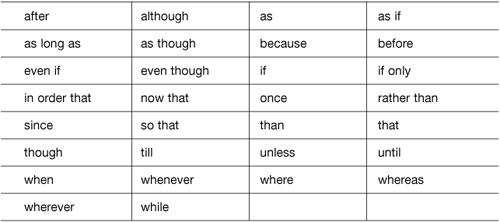
SUFFIX
Words whose roots end with -ge or -ce generally retain the e when a suffix is added.
Example: change, changeable.
Example: damage, damageable.
Example: disadvantage, disadvantageous
Example: outrage, outrageous.
A final silent e is usually dropped before a suffix that begins with a vowel.
Example: argue, arguing.
Example: change, changing.
Example: conceive, conceivable.
A final silent e is usually retained before a suffix that begins with a consonant.
Example: achieve, achievement.
Example: definite, definitely.
In words ending in -c, add k before a suffix beginning with -e, -i, or -y, so that the hard sound of the original c is retained.
Example: frolic, frolicked, frolicking.
Example: mimic, mimicked, mimicking.
Example: picnic, picnicked, picnicking.
A word ending in -ie changes the -ie to -y when adding a suffix.
Example: die, dying.
Example: lie, lying.
Example: tie, tying.
Words that end in -y preceded by a vowel retain the y when adding the suffix.
Example: survey, surveying, surveyor.
Words that end with -y preceded by a consonant change y to i when adding a suffix, except when the suffix is -ing.
Example: embody, embodying, embodied.
Example: rely, relying, relied.
Example: satisfy, satisfying, satisfied.
A final consonant is usually doubled when it is preceded by a single vowel and takes a suffix.
Example: mop, mopping.
A final consonant is doubled when it is followed by a suffix, and the last syllable is accented when the suffix is addedd.
Example: acquit, acquitted
The final consonant is not doubled when the accent is shifted to a preceding syllable when the suffix is added and when the final consonant is preceded by two vowels.
Example: refer, referring, reference.
Example: fooled, fooling.
SUMMATIVE MODIFIER
A summative modifier renames or summarizes what has been going on earlier in the sentence and adds new information.
Example: The email etiquette seminar promises to show employees how to write effective emails, emails that get results, and emails that result in a positive image for your business—three benefits [summative modifier] that can enhance the productivity of any business.
SUPERLATIVE
A superlative is a type of adjective or adverb that depicts something that is of a higher quality than something else. There must be three or more items compared in order to use the superlative.
The superlative is formed by adding the definite article the, along with either a short adjective that adds the suffix -est or a longer adjective that adds most.
Example: Mount Rainer is the tallest [superlative] volcano in North America.
Example: He is the most friendly guy on the team.
SYLLABLE
Syllables are individual sounds that make up a word. A syllable can be said without interruption.
Most syllables have at least one vowel and other consonants before or after the vowel.
Example: Syllable has three syllables: syl-la-ble.
SYMBOLS AND SPECIAL CHARACTERS
Symbols and other special characters may be used in business documents for mathematical equations, formulas, measurements, and punctuation; they can also be employed as bullets and attention-getting characters in page layouts.
When instructing a reader to type a symbol or special character to complete a procedure, spell the name of the character and include the symbol enclosed in parentheses.
Example: In an email address, type the at sign (@) and a period (.) before the domain name.
Table 2.28 contains a list of symbols and special characters and their names.
Table 2.28 Symbols, Special Characters, and Their Names
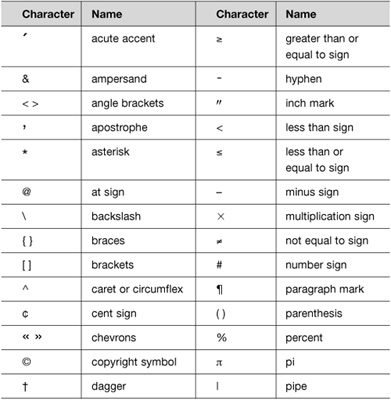
SYMPATHY, EMPATHY
SYNECDOCHE
Synecdoche is a figure of speech where a phrase features one thing that is used to refer to a related thing.
Example: All hands [figure of speech for people or sailors] on deck.
SYNONYMS
A synonym is a word that has the same or a very similar meaning as that of another word. In most cases, a synonym of a word may be substituted for the original word.
Example: car, automobile; film, movie; woman, lady; happy, joyful; bad, terribl.

